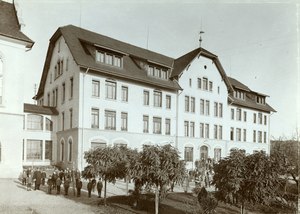
Unternavigation
Homes and Institutions
A wide range of social homes and institutions emerged in Switzerland since the 19th century. They are dedicated to promoting the education, provision and discipline among certain groups of the population often affected by poverty. These care placements came with stigma and discrimination until into the 1980s but have since undergone fundamental reform.
The history of welfare and foster homes and institutions is complex and often difficult to comprehend. Poor relief (social welfare) has always been characterized by a wide range of private and public organisations. It also belongs to the areas of the Swiss welfare state that are federally structured and relatively unregulated.
From the Medieval Hospital to the Poorhouses of the 19th Century
The institutions and homes of modern welfare follow in the tradition of medieval and early-modern hospitals that also served as shelters for the destitute, welfare centres for widows and orphans, infirmaries, mental asylums and prisons. Early-modern hospitals developed into communal infirmaries and old people’s homes in the course of the 19th century.
The poor have had an obligation to work since the Middle Ages, which could come in the form of forced labor (often as Schellenwerkin the Swiss context; see above) or in hospitals. Institutions specifically for correctional or forced labor purposes were founded in the 17thcentury, or existing hospitals were converted for such uses.
At the end of the 18th and beginning of the 19th century, Swiss pioneers of education for the poor, such as Johann Heinrich Pestalozzi and Philipp Emanuel von Fellenberg, set new pedagogical standards that paved the way for the establishment of educational institutions throughout the 19th century. Children and youths at these institutions had to perform manual work in agriculture or a commercial trade. The work was intended to provide them with the moral principles needed for their subsequent integration into society. This corresponded to the contemporary belief at the time that the cause of poverty typically lay in indecent moral conduct.
The poorhouses were run in connection with the public welfare of the 19th century, which stipulated that destitute families had to be supported by the home municipality. However, the municipal authorities often split families up and placed children in foster homes, institutions or private households (indentured child laborers) in order to keep the level of financial support low. Most of the children affected came from the lower classes or were born out of wedlock.
The homes were forced to keep costs at a minimum. They did so, for instance, by exploiting the children and youths as laborers and sources of income. The pay of the staff at the often public, but usually non-profit or charitable institutions were typically low and they were poorly trained and overworked. Furthermore, the lack of supervision from authorities contributed to the disastrous conditions in many homes. Many children in homes were malnourished, suffered from a lack of human care and were often subjected to violence or sexual abuse by their carers. The primary and vocational education was frequently insufficient, leading to lasting consequences for their personal development and professional careers.
The 19th century also saw the emergence of many specific institutions such as homes for people with disabilities, clinics and care facilities for the mentally ill and penal institutions for delinquents. They all performed two functions: to provide for their residents and to exclude them from the rest of society.
Homes and Coercive Welfare Measures Since 1900
The rise of the welfare state since the 1900s also marked the beginning of a long process that gradually detached the practice of placements in homes and institutions from stigma and discrimination and highlighted nursing, therapeutic and special educational motives instead. By the final decades of the 20th century impoverished families should be able to keep custody of their children, thanks to a number of social welfare programs.
In practice, a large number of children and youths – up to five per cent of children aged under 14 according to estimates – continued to grow up in foster families or homes in the 20th century. Many were placed into homes because their family circumstances were considered economically precarious or dubious from a moral perspective. The new Civil Code of 1907 provided for the removal of children and for placements in foster homes or private households if a child was ‘neglected’ or ‘endangered in their physical and mental wellbeing’. A divorce or an illegitimate birth was often provided sufficient grounds for removing children. Difficult children and youths were also sent to closed institutions. The authorities could carry out such ‘administrative measures’ without a court verdict or the option of legal appeal. Children were also removed for racist motives. For instance, Pro Juventute ran the so-called welfare programme ‘Kinder von der Landstrasse’ from 1926 to 1972, which removed around 600 children from travellers, particularly Sinti and Yenish families. Many of those subject to ‘administrative measures’ performed forced labor in the institutions where they were placed.
In the 1970s, a critical public campaigned against the abuses in foster homes and institutions and brought about improvements to care conditions and education methods. For example, in 1981, the practice of ‘administrative measures’ was abolished and replaced with the option of imprisonment for negligent parents and guardians. The European Convention on Human Rights, ratified by Switzerland in 1974, also played a key role in repealing questionable powers previously wielded by the authorities.
Literatur / Bibliographie / Bibliografia / References: Markus Furrer et al. (ed.) (2014), Fürsorge und Zwang. Fremdplatzierung von Kindern und Jugendlichen in der Schweiz 1850-1980 / Entre assistance et contrainte: le placement des enfants et des jeunes en Suisse 1850-1980, Basel ; Martin Lengwiler et al. (2013), Bestandsaufnahme der bestehenden Forschungsprojekte in Sachen Verding- und Heimkinder. Bericht zuhanden des Bundesamts für Justiz EJPD, Basel.
(12/2016)




